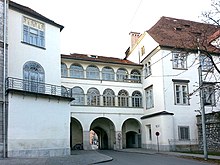Burgtor (Graz)
The Burgtor is located at the interface between Hofgasse and Erzherzog-Johann-Allee . It is at the Graz District Inner City and is part of the city of Graz crown (Graz section Grazer City crown ). In addition to the Outer Paulustor , the building is the only remaining wall gate in the city of Graz.
History and design
A so-called “gate against the Grecz” is already mentioned by the Babenbergers, whereby the term “Grecz” is a name for the Grazbach or the Kroisbach . The gate was still at the level of the theater , under Emperor Friedrich III. a move to the current location took place. Depending on the sources, the construction date of the new city gate is dated to 1336 or 1346 - here with the first documentary mention. With the addition of the Graz Castle in 1440, the gate was given the name that is still valid today. The castle gate has had several names in the course of its history: “Pfarrtor” or “St. Gilgen Gate”. It is considered to be the "most firmly developed city gate"
About a hundred years later, at the time of the Renaissance, the castle gate was simply called “clock gate” because of its structure with a clock and bell. The current appearance of the castle gate dates from around 1440 and 1640. The simple, city-side facade is in the Gothic style, the side facing the city park in the Renaissance style . The gate opening consists of Gothic pointed arch stone gates and a barrel-vaulted passage.
The castle gate was firmly closed between 1479 and 1784 due to various sources of danger. Attempts by the citizens to open the gate at least temporarily failed. It was not until Emperor Joseph II declared Graz an “open city”. So you could pass the city gate again after more than 300 years. The former gate guard house and today's Café Promenade still stands in front of the Burgtor in the Graz city park . The low building with the characteristic Doric columns has been in existence since 1837.
literature
- Fritz Popelka: History of the City of Graz. Vol. 2. Schroll, Graz, Vienna, Cologne 1960.
- Horst Schweigert: DEHIO Graz . Schroll, Vienna 1979, ISBN 3-7031-0475-9 , p. 49 .
- Robert Engele: The gate guard house is now a nice café . From the series Damals in Graz in the Styrian edition of the Kleine Zeitung of October 23, 2011. pp. 42–43.
Individual evidence
- ↑ Graz city gates then and now. Memories and stone witnesses of a once fortified city by Dr. Reinhard Sudy
- ↑ a b Schweigert: Dehio Graz. P. 49.
- ↑ a b c Robert Engele: The gate guard house is now a nice café . From the series At that time in Graz in the Styrian edition of the Kleine Zeitung of October 23, 2011. p. 42.
- ^ Fritz Popelka: History of the City of Graz. Vol. 2. , p. 17.
- ^ Fritz Popelka: History of the City of Graz. Vol. 2. , p. 18.
Coordinates: 47 ° 4 ′ 19.8 " N , 15 ° 26 ′ 34.9" E


